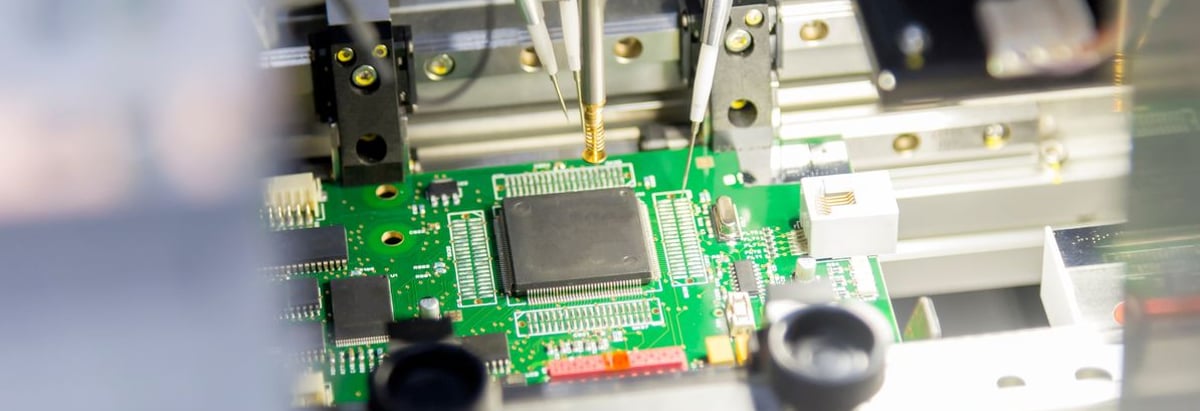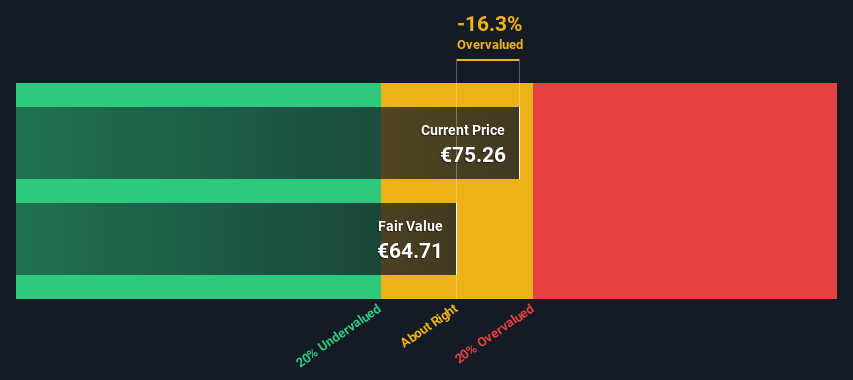- Netherlands
- /
- Semiconductors
- /
- ENXTAM:BESI
A Look At The Intrinsic Value Of BE Semiconductor Industries N.V. (AMS:BESI)

Key Insights
- The projected fair value for BE Semiconductor Industries is €64.71 based on 2 Stage Free Cash Flow to Equity
- With €75.26 share price, BE Semiconductor Industries appears to be trading close to its estimated fair value
- The €80.83 analyst price target for BESI is 25% more than our estimate of fair value
Today we will run through one way of estimating the intrinsic value of BE Semiconductor Industries N.V. (AMS:BESI) by taking the expected future cash flows and discounting them to today's value. We will take advantage of the Discounted Cash Flow (DCF) model for this purpose. There's really not all that much to it, even though it might appear quite complex.
We generally believe that a company's value is the present value of all of the cash it will generate in the future. However, a DCF is just one valuation metric among many, and it is not without flaws. Anyone interested in learning a bit more about intrinsic value should have a read of the Simply Wall St analysis model.
See our latest analysis for BE Semiconductor Industries
The Model
We're using the 2-stage growth model, which simply means we take in account two stages of company's growth. In the initial period the company may have a higher growth rate and the second stage is usually assumed to have a stable growth rate. To start off with, we need to estimate the next ten years of cash flows. Where possible we use analyst estimates, but when these aren't available we extrapolate the previous free cash flow (FCF) from the last estimate or reported value. We assume companies with shrinking free cash flow will slow their rate of shrinkage, and that companies with growing free cash flow will see their growth rate slow, over this period. We do this to reflect that growth tends to slow more in the early years than it does in later years.
A DCF is all about the idea that a dollar in the future is less valuable than a dollar today, so we need to discount the sum of these future cash flows to arrive at a present value estimate:
10-year free cash flow (FCF) forecast
| 2023 | 2024 | 2025 | 2026 | 2027 | 2028 | 2029 | 2030 | 2031 | 2032 | |
| Levered FCF (€, Millions) | €212.9m | €273.6m | €345.6m | €410.3m | €416.7m | €421.3m | €424.9m | €427.9m | €430.4m | €432.5m |
| Growth Rate Estimate Source | Analyst x3 | Analyst x3 | Analyst x1 | Analyst x1 | Analyst x1 | Est @ 1.09% | Est @ 0.86% | Est @ 0.70% | Est @ 0.59% | Est @ 0.51% |
| Present Value (€, Millions) Discounted @ 8.0% | €197 | €235 | €274 | €302 | €284 | €266 | €248 | €231 | €216 | €201 |
("Est" = FCF growth rate estimated by Simply Wall St)
Present Value of 10-year Cash Flow (PVCF) = €2.5b
The second stage is also known as Terminal Value, this is the business's cash flow after the first stage. The Gordon Growth formula is used to calculate Terminal Value at a future annual growth rate equal to the 5-year average of the 10-year government bond yield of 0.3%. We discount the terminal cash flows to today's value at a cost of equity of 8.0%.
Terminal Value (TV)= FCF2032 × (1 + g) ÷ (r – g) = €433m× (1 + 0.3%) ÷ (8.0%– 0.3%) = €5.7b
Present Value of Terminal Value (PVTV)= TV / (1 + r)10= €5.7b÷ ( 1 + 8.0%)10= €2.6b
The total value is the sum of cash flows for the next ten years plus the discounted terminal value, which results in the Total Equity Value, which in this case is €5.1b. To get the intrinsic value per share, we divide this by the total number of shares outstanding. Compared to the current share price of €75.3, the company appears around fair value at the time of writing. Valuations are imprecise instruments though, rather like a telescope - move a few degrees and end up in a different galaxy. Do keep this in mind.

Important Assumptions
Now the most important inputs to a discounted cash flow are the discount rate, and of course, the actual cash flows. If you don't agree with these result, have a go at the calculation yourself and play with the assumptions. The DCF also does not consider the possible cyclicality of an industry, or a company's future capital requirements, so it does not give a full picture of a company's potential performance. Given that we are looking at BE Semiconductor Industries as potential shareholders, the cost of equity is used as the discount rate, rather than the cost of capital (or weighted average cost of capital, WACC) which accounts for debt. In this calculation we've used 8.0%, which is based on a levered beta of 1.290. Beta is a measure of a stock's volatility, compared to the market as a whole. We get our beta from the industry average beta of globally comparable companies, with an imposed limit between 0.8 and 2.0, which is a reasonable range for a stable business.
SWOT Analysis for BE Semiconductor Industries
- Debt is not viewed as a risk.
- Earnings declined over the past year.
- Dividend is low compared to the top 25% of dividend payers in the Semiconductor market.
- Annual earnings are forecast to grow faster than the Dutch market.
- Good value based on P/E ratio compared to estimated Fair P/E ratio.
- Dividends are not covered by earnings and cashflows.
- Revenue is forecast to grow slower than 20% per year.
Looking Ahead:
Although the valuation of a company is important, it ideally won't be the sole piece of analysis you scrutinize for a company. DCF models are not the be-all and end-all of investment valuation. Instead the best use for a DCF model is to test certain assumptions and theories to see if they would lead to the company being undervalued or overvalued. For example, changes in the company's cost of equity or the risk free rate can significantly impact the valuation. For BE Semiconductor Industries, there are three additional elements you should further examine:
- Risks: To that end, you should learn about the 3 warning signs we've spotted with BE Semiconductor Industries (including 1 which is a bit concerning) .
- Management:Have insiders been ramping up their shares to take advantage of the market's sentiment for BESI's future outlook? Check out our management and board analysis with insights on CEO compensation and governance factors.
- Other High Quality Alternatives: Do you like a good all-rounder? Explore our interactive list of high quality stocks to get an idea of what else is out there you may be missing!
PS. Simply Wall St updates its DCF calculation for every Dutch stock every day, so if you want to find the intrinsic value of any other stock just search here.
Valuation is complex, but we're here to simplify it.
Discover if BE Semiconductor Industries might be undervalued or overvalued with our detailed analysis, featuring fair value estimates, potential risks, dividends, insider trades, and its financial condition.
Access Free AnalysisHave feedback on this article? Concerned about the content? Get in touch with us directly. Alternatively, email editorial-team (at) simplywallst.com.
This article by Simply Wall St is general in nature. We provide commentary based on historical data and analyst forecasts only using an unbiased methodology and our articles are not intended to be financial advice. It does not constitute a recommendation to buy or sell any stock, and does not take account of your objectives, or your financial situation. We aim to bring you long-term focused analysis driven by fundamental data. Note that our analysis may not factor in the latest price-sensitive company announcements or qualitative material. Simply Wall St has no position in any stocks mentioned.
About ENXTAM:BESI
BE Semiconductor Industries
Engages in the development, manufacture, marketing, sale, and service of semiconductor assembly equipment for the semiconductor and electronics industries in China, the United States, Malaysia, Ireland, Korea, Taiwan, Thailand, Other Asia Pacific and Europe, and internationally.
Exceptional growth potential with excellent balance sheet.


